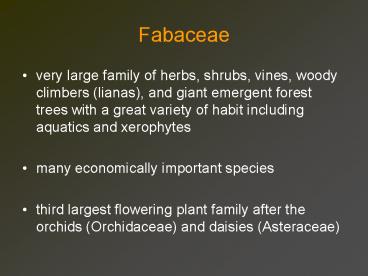Fabaceae - PowerPoint PPT Presentation
1 / 26
Title:
Fabaceae
Description:
Distribution cosmopolitan distribution in tropical, subtropical and temperate zones. found as major components of most of the world's vegetation types and many have ... – PowerPoint PPT presentation
Number of Views:5597
Avg rating:3.0/5.0
Title: Fabaceae
1
Fabaceae
- very large family of herbs, shrubs, vines, woody
climbers (lianas), and giant emergent forest
trees with a great variety of habit including
aquatics and xerophytes - many economically important species
- third largest flowering plant family after the
orchids (Orchidaceae) and daisies (Asteraceae)
2
- Distribution cosmopolitan distribution in
tropical, subtropical and temperate zones - found as major components of most of the worlds
vegetation types and many have the ability to
colonize marginal or barren lands because of
their capacity to fix atmospheric nitrogen
through root nodules
3
Diagnostic Features
- Lvs. alt. pinnately compd. and stipulate
- Ulex has simple and small lvs.
- Acacia can have petioles flattened into phyllodes
- stipular spines in some species of Acacia and
Robinia - garden pea has large, leaf like stipules
- leaves could be trifoliolate eg Trifolium and
Medicago - lvs. can alter their position at night by folding
- lvs. of Mimosa pudica can open by shock stimulus
(pulvinus) - tendrils or hooks are modified branches, lvs. or
leaflets
4
(No Transcript)
5
(No Transcript)
6
Subfamily Caesalpinioideae
- trees, shrubs and lianas
- flws. relatively large, generally zygomorphic
- petals imbricate in bud, sepals free, petals most
showy part - lvs. pinnate or bipinnate
- stamens 10, sometimes dimorphic or heteromorphic
- root nodules uncommon
7
(No Transcript)
8
Cassia
Delonix regia
9
Subfamily Mimosoideae
- trees, shrubs, lianas, rarely aquatic herbs
- small, regular flws. aggregated into heads or
spikes, actinomorphic - petals valvate in bud, sepals and petals
generally united at base - lvs. mainly bipinnate and often with specialized
glands Australian Acacias with phyllodes - stamens 10-many (sometimes over 100), all the
same, most showy part - root nodules generally present
10
Albizia
11
Subfamily Papilionoideae
- herbs, shrubs, trees, lianas, and twiners
- flws. pea-like (papilionaceous corolla),
zygomorphic - petals imbricate in bud, median petal (standard,
vexillum or banner) overlaps others, sepals
united at base into a calyx tube, petals most
showy part - lvs. simple or once pinnate, a few palmate, some
with tendrils, only one rare species bipinnate - stamens 9-10-many (sometimes dimorphic)
- root nodules generally present
12
(No Transcript)
13
(No Transcript)
14
Diagnostic Features (cont.)
- Gynoecium all legumes have a single carpel,
superior ovary - Fruit one chambered pod (legume) or constricted
in the middle (lomentum / loment) - sometimes indehiscent as in groundnut, Arachis
- may dehisce explosively in Ulex and Lupinus
- legumes may be dry or fleshy, inflated or
compressed, winged or not, greenish or brightly
colored and range in size from a few mm to 30cm
15
Desmodium
Tamarindus
Caesalpinia
Entada
16
(No Transcript)
17
Classification
- Division Magnoliophyta
- Class Magnoliopsida
- Subclass Rosidae
- Order Fabales
- Family Fabaceae
18
Classification
- consists of 727 genera and 19325 species
- monospecific genera 192 (26)
- genera with 2-10 spp. 304 (42)
- genera with 11-19 species 190 (26)
- genera with 100 or more spp. 41 (6)
19
Classification
- Fabaceae is divided into 3 subfamilies and 36
tribes - subfamily Caesalpinioideae comprises 4 tribes and
2250 species - subfamily Mimosoideae comprises 4 tribes and 3270
species - subfamily Papilionoideae has 28 tribes and 13800
species
20
Top Legume Genera
- Astragalus 2400 species
- Acacia senu lato 1450 species
- Indigofera 700 species
- Crotolaria 690 species
- Mimosa 500 species
21
- over a quarter of the species in the family occur
in just the four largest genera - nearly 500 legume genera (68) are small, being
either monospecific or containing up to 10
species - it is now generally accepted that the Leguminosae
is more closely related to Polygalaceae,
Suriniaceae, and Quillajaceae, which together
form the order Fabales - thought to be related to the Connaraceae and
Sapindaceae in the past
22
Economic Importance
- as important as grasses but range of use is
broader - legume products contribute enormously to the
worlds economy through - food (animals and humans), drinks
- pharmaceuticals, medicine
- biodiesel fuel, biotechnology
- building and construction, textile, furniture,
crafts - mining, paper and pulp, manufacturing processes
- chemicals and fertilizers, waster recycling
- horticulture, pest control, ecotourism
23
- Ceratonia siliqua is used for carob (original
carat used as a standard weight by jewellers),
used as chocolate substitute and coffee
substitute carob gum used in foods and
cosmetics, inks, paints, polishes, etc.
24
- 40 to 60 million metric tons of nitrogen are
fixed annually by agriculturally important
legumes and 3-5 million metric tons by legumes in
natural ecosystems - grain and forage legumes are grown on approx. 180
million hectares (12 to15) of the Earths arable
surface and account for 27 of the worlds
primary crop production
25
- 33 of dietary protein needs of humans are
satisfied by legumes - main dietary legumes (pulses) include several
species of bean (Phaeseolus), pea (Pisum
sativum), chickpea (Cicer arietinum), broad bean
(Vicia faba), pigeon pea (Cajanus cajan), cowpea
(Vigna unguiculata) and lentil (Lens culinaris) - legumes like soybean (Glycine max) and peanut
(Arachis hypogaea) contribute to more than 35 of
the worlds processed vegetable oil
26
- legumes are used widely in the temperate and
tropical biomes as forage crops eg Medicago
sativa (alfalfa) and Lotus corniculatus in North
America































